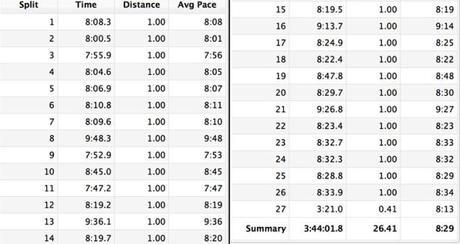If you can’t fly then run, if you can’t run then walk, if you can’t walk then crawl, but whatever you do you have to keep moving forward.
― Martin Luther King Jr.
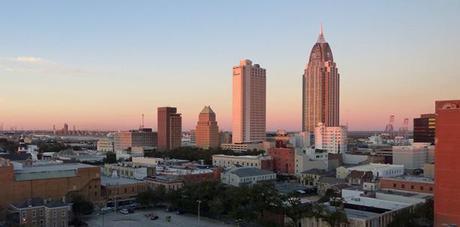
Upwardly Mobile: The RSA Trustmark Building and Battle House Tower stand tall at sunset…
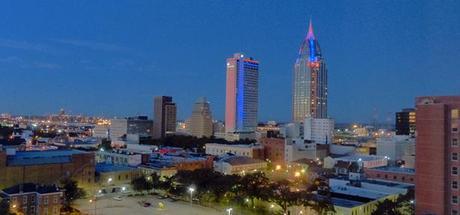
… and at dusk, in electric red-and-blue evening wear
The irony struck me immediately. After hearing “Sweet Home Alabama” no fewer than three times during our first six hours in Mississippi, what greeted me now as I strolled through the lobby of the Holiday Inn in Mobile, Alabama was the equally classic guitar riff from “Hotel California”.
Certainly Mobile felt more like California than had Jackson, if for no other reason than its proximity to Mobile Bay and the Gulf of Mexico. And the distinctively patriotic red and blue illumination of the three buildings that dominate its downtown landscape (including the 35-story RSA Battle House Tower, the tallest building in Alabama) does lend Mobile, by night at least, a more metropolitan vibe than anything we’d encountered in Jackson.
We’d arrived in Mobile under cover of darkness after a 200-mile drive from Jackson, where that Saturday morning I’d run the Mississippi Blues Marathon. After a quick check-in to unload our bags, we vamoosed across the street to catch the pre-race expo and pasta carbo-load for the weekend’s second marathon – the Servis1st Bank First Light Marathon.
Several months earlier, I’d seen an article on either Active.com or Competitor.com (probably both) with tips on how to beat the “post-marathon blues,” that emotionally lethargic period following intense exercise when jacked-up levels of adrenaline, dopamine, serotonin and other neurotransmitters return to baseline. On this weekend, my own solution to the post-marathon blues would be to avoid the post-race period altogether – by running another marathon the next day. Race, rest, repeat. I have a doctorate in biology, so clearly this was brilliant scientific problem-solving on my part.
In the high-ceilinged atrium of the Mobile Government Plaza building, the First Light Marathon expo was smaller and even more low-key than the Mississippi Blues expo had been. Included with my race registration was a “BACK 2 BACK” long-sleeve tech t-shirt (in addition to the normal race t-shirt) and a colorful handmade plaque designed exclusively for runners who would be running both races. Each plaque was painted by a member of the Mobile chapter of L’Arche, an “international federation of communities in which people with intellectual disabilities and those who help them can live, work, and share their lives together.” The race itself would benefit L’Arche Mobile, and as a long-time supporter of Special Olympics, I’m partial to any organization whose mission is to empower special-needs individuals.
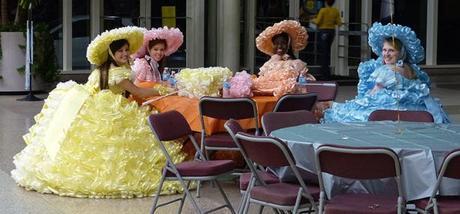
A colorful reminder that y’all are in the Heart of Dixie, now!
Although I’d known there’d be other back-to-backers here (Marathon Maniacs are, after all, omnipresent runneroids), I was floored by the numbers posted at the expo: out of 1,310 total marathoners and half marathoners, a whopping 28% (372) would be running their second race of the weekend. Unfortunately I don’t know how many of those 372 were full marathoners… but never let it be said that running is an addiction.
Sidling up to the well-stocked pasta buffet before it closed, I fell in line across from another back-to-backer who immediately shared the fact that he’d twisted his ankle that morning on Mississippi’s uneven streets (which weren’t nearly as uneven as I’d expected), and that as a vegan he hadn’t eaten pasta in months – though what not eating pasta had to do with being vegan was unclear (maybe he’d grown up on Chef Boyardee Lard-a-roni?). If within ten seconds of meeting you I know your dietary habits, and your name’s not Scott Jurek, you could probably be making a better first impression.
But even better was his second impression. Moving on to the drink table with no hint of a limp, he pointed to a cup filled with what looked to be iced tea and asked the older gentleman manning the table, “What is this?” “Sweet tea,” the man replied in a measured Southern lilt. “What’s it sweetened with?” volleyed his guest. “Um… sugar,” was the matter-of-fact response. “So, like, REAL sugar, not that high-fructose stuff?” pressed the younger man. At that point our host apparently decided it was time to finalize this exchange: “Son, you’re in Alabama… it’s sugar.” Stifling a laugh, I grabbed a cup of water with my free hand to keep from high-fiving the older man. If the real world came with a floating “Like” button, I would’ve punched it at that moment.
The next 30 minutes I spent restocking my diminished carbohydrate stores (that’s runner–speak for “stuffing my face”). Satiated, we retired to our room to resume my painful play date with the sadistic Orb, and to catch up on lost sleep from the night before. Gazing up at the ceiling, just visible in the soft electric glow outside our window, I anticipated the next morning’s zombie-like stiffness, and pondered the potentially cruel irony of running my second marathon of the weekend in a town called Mobile.
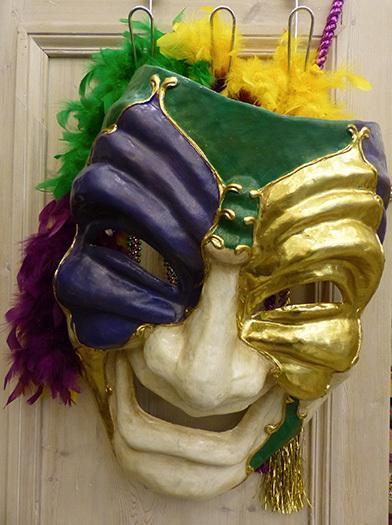
Mobile’s true claim to fame may be as the birthplace of Mardi Gras
(Mobile Carnival Museum)
The calm before the storm (start – mile 8)
It’s Sunday 6:00am, and my brain knows full well for whom the alarm bell tolls. After 7+ hours of solid sleep (which in pre-race equivalents might as well be 20), it awakens ready to hit the ground running and ensure my body does the same. Sympathetic signals fire along neural projections and hurdle busy synapses, poking and prodding my still-sleeping legs to assess their status for the 26.2-mile day ahead. Sensing a minor muscular mutiny in progress, my brain sends another signal instructing both hands to attack the right iliotibial band with passion and prejudice. Lazily I pass the directive along to Katie, whose own hands painfully (and a bit sadistically, I note) quell the mutiny before its message of dissension can spread to other impressionable muscle groups.
And with that, I’m ready to race. Sliding out of bed, I felt surprisingly as though Saturday had never happened. Legs? Strong. Feet? Rested. Even the residual abdominal soreness from an ill-advised workout earlier in the week had faded. Outside sunny skies beckoned, and on the street below randomly diffusing individuals were beginning to coalesce into something more deliberate. So after a breakfast indistinguishable from – though slightly less frozen than – the day before, we descended the 15 stories to join the start line festivities on the street corner outside our hotel. Nothing beats lodging within easy walking distance of the start line, I highly recommend it. And smaller races enable it.
Donning light gloves, I fist-bumped Katie and positioned myself among the brightly colored throngs as the singing of “The Star-Spangled Banner” was ending. A minister stepped forward to bless the race (a distinctly Southern touch), thereby ensuring that nothing could possibly go wrong for the next eight hours. As runners of all shapes and sizes stood restlessly waiting… waiting… waiting… I wondered whether my imperceptible shivering was due to the early morning chill (owing to a start temperature of 37ºF) or to the butterflies in my stomach at the prospect of chasing down a second consecutive sub-3:45 finish. Then the {CRACK} of the starter pistol sliced through my thoughts, the crowd pressed forward, and marathon #11 in state #7 was underway.
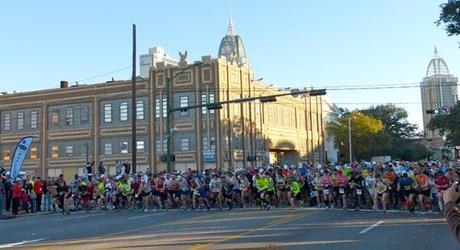
The no-frills, stay-in-that-crosswalk-until-the-gun-goes-off start line
As the third largest town in Alabama, Mobile is slightly more populated than Jackson, where I’d been running 24 hours earlier. But I could tell immediately that today’s race, like the previous night’s expo, would have a more small-town feel. For one thing, there were no conspicuous pace groups. And crossing a start line devoid of the usual blue and red timing mat, it hit me that I’d seen no evidence of a timing chip on either my bib or in my goodie bag.
Timing chips are worn to track a runner’s progress and assign an exact finish time based on when he/she crosses the start and finish lines. Without a timing chip, every runner’s finish time is based solely on “gun time,” that is, how long it takes them to cross the finish line from the moment the starter pistol fires, no matter how long it takes them to cross the start line. In that situation, all else being equal, those who line up nearer the start line have an inherent advantage over those who start farther back. Timing chips eliminate the anxiety caused by the inevitable hurry-up-and-wait of the start line bottleneck. But today in Mobile – sans timing chip – that anxiety was in full bloom, and by starting back in the pack I’d already relinquished a minute or so before I’d even crossed the start line.
Not that I was legitimately concerned… after all, I‘d just run a comfortable 3:43:36 in Jackson the day before. And today’s cool weather was even more race-friendly. But again, I was in uncharted territory here with my second marathon of the weekend, and it was still unclear how my body would respond to the challenge. I’ve seen how quickly the wheels can fall off on race day for even the most prepared runners.
And I planned to be among the most prepared runners in Mobile. In the past two months I’d logged two 70-mile weeks and two more 60-mile weeks. November had been a 278-mile training month. Over the holidays I’d run cold 19-milers on consecutive days through the mind-numbing monotony of suburban Dallas – a decidedly unappealing place to be a pedestrian, much less a runner.
Bottom line: my goal here in Mobile was to reach the finish line in less than 3 hours, 45 minutes. And if, three hours from now, I found myself balled up in the fetal position beside the mile 20 aid station, gently cajoling my precious legs in my best Gollum voice, then so be it.
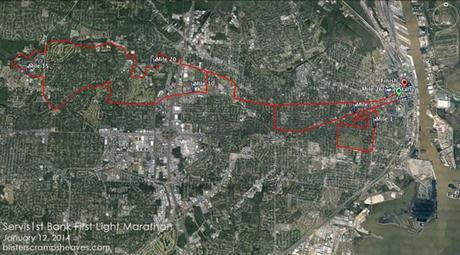
That dirt-brown swath to the far right is the Mobile-Tensaw River emptying into Mobile Bay
(Google Earth; click on the image for a larger version)
It took only a hundred yards or so to convince myself that all muscle groups were not only present and accounted for, but were in fact feeling good, with no hint of fatigue. And so I maintained a comfortably fast pace (8:00-8:10/mile) for the first few miles over uneven residential streets. Although the organizers of the Mississippi Blues Marathon had warned us in advance about the iffy condition of their streets (“they’ve got some blues of their own”), I actually found the streets in Mobile to be more shady – in part because they were more shady. Sparsely clad tree limbs filtered the morning sunlight, bathing the street in irregular patterns of light and shadow that made it tough to track my footing. And so my attention early in the race focused on doing just that.
Nearby church bells resonated loudly, heralding the start of Sunday mass. My own thoughts turned momentarily to my dad as we passed the Mobile National Cemetery late in mile 2. He and I had actually stayed overnight in Mobile (my only previous visit to Alabama) in the early 80s, on an epic father-son road trip to Disney World.
In the context of Alabama vs. Mississippi, Mobile struck me as more glossy than Jackson, with fewer rough edges. Then again, Katie and I hadn’t had a chance to show ourselves around before the race as we had in Jackson, so I was only privy to what the race organizers wanted us to see – namely middle- to upper-class neighborhoods, commercial stretches of small businesses and strip malls, highway overpasses, two universities (University of South Alabama and Springhill College), and the Azalea City Golf Course.
As the home of baseball greats Hank Aaron, Satchel Paige and Willey McCovey, Mobile also struck me as much whiter than I’d expected. Although 2010 census numbers estimated the African-American population at just over 50% (compared to 79% in Jackson), the Mobile I saw presented a more homogenous ethnic profile. Again, though, I tend to think that reflects the neighborhoods in which we ran and stayed. In any case, the field of runners was definitely more monochromatic than it had been the day before in Mississippi.
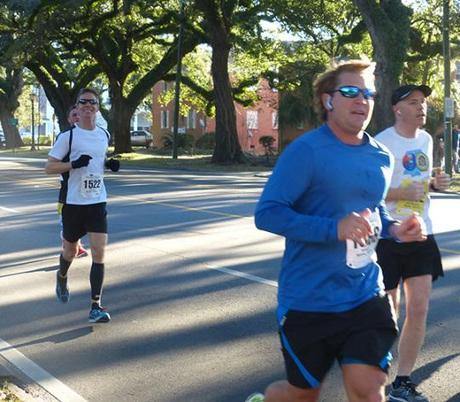
In early pursuit of my blue-shirted friend at mile 5
Carbo-unloading (mile 8 – mile 21)
Approaching mile 8 at an 8:05/mile clip, my stomach began to feel like a bounce house hosting a birthday party. Curious, I thought. Only once before – during my first marathon, in Long Beach back in 2010 – had I ever made an in-race pitstop. But today my gut left me no choice, and so I pulled up to two aid station porta-potties alongside another runner in a long-sleeve blue shirt. As he and I waited, I stared impatiently at the red dots on the doors signaling both stand-alone plastic closets were in use. Good thing I’m in no hurry today, I mused as 15, then 30, then 45 seconds ticked away.
After nearly a minute of wait time, I finally gained access and quickly rejoined the race with a more settled stomach, ramping up my pace to make up for lost time. Soon I passed my companion in the blue long-sleeve shirt, and normalcy looked to have been restored.
But denial, to quote SNL’s Stuart Smalley, isn’t just a river in Egypt. And apparently the other body parts had appointed the stomach their spokes-organ for the day, because whereas my muscles, tendons and ligaments all felt strong and responsive, my stomach would end up filing several more urgent grievances:
At mile 10.
And mile 12.
And mile 16.
And mile 21.
Thankfully this was only a marathon and not a long race.
“Enjoy the runs!  ” a friend on Facebook had exhorted me upon learning I’d be racing in Mississippi and Alabama on consecutive days. I’m pretty sure this wasn’t what he’d had in mind.
” a friend on Facebook had exhorted me upon learning I’d be racing in Mississippi and Alabama on consecutive days. I’m pretty sure this wasn’t what he’d had in mind.
Amazingly, despite three stops in the first twelve miles, I reached the halfway point at an 8:20/mile pace, well ahead of my 3:45 finish goal (8:35/mile) and nearly identical to my first-half split in Jackson. If not for my gut’s capriciousness, I would actually have been enjoying my second marathon in 24 hours, and might even have entertained the thought of chasing a 3:35 finish.
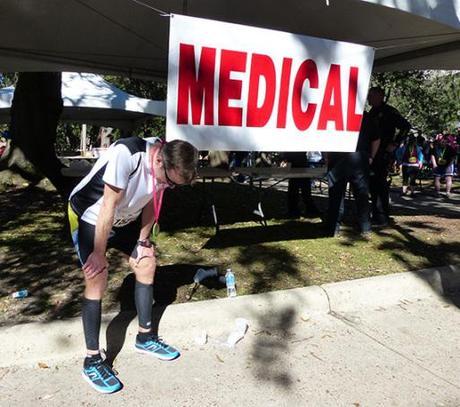
No doubt the medical tent’s proximity to the food tent was purely coincidental
After each unscheduled stop, I hurried to catch up to the imaginary Back-to-the-Future me who wasn’t having GI issues. My stomach may be captaining this ship, but damned if I was going to let it steer me on to the rocks. And each time I’d pull up alongside my blue-shirted buddy (who quickly became my de facto pacer after each pitstop), he’d have a few light-hearted words for me:
At mile 10: “You have to stop again, brother?” I explained that I’d raced in Mississippi the day before, and that my stomach was apparently confused at having to repeat the process today.
At mile 12: “Wow, how fast did you run that race yesterday?”, probably thinking I must’ve run like my hair was on fire to warrant such persistent complications.
At mile 16: “I’d hate to see how fast you’d run this thing without stopping!” You and me both, friend-o. At that point he told me he was shooting for a 3:40-3:45 finish, so I felt good about my chances as long as I stayed ahead of him. And whenever I’d pull ahead of him, I was able to chart his progress and proximity by the timbre of the “War Eagle!” with which he enthusiastically greeted any spectator sporting Auburn University apparel.
By mile 21, though, I was sadly on my own, having pulled far enough ahead that not even one last carbo-unloading session on my part would allow my affable 3:45 pacer to overtake me. Now if I could just maintain my pace for five more miles.
Five long miles. Five very long miles. Five of the most joyless miles I’d ever run.
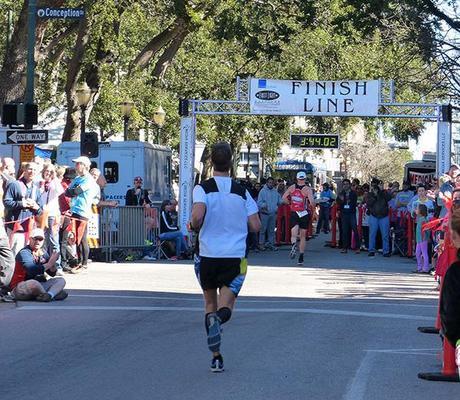
Based on that street sign in the upper left, euphoria begins at the moment of Conception
Finishing strong not weak (mile 21 – finish)
The realization dawned on me that with each successive pitstop, it wasn’t time I was losing so much as it was more and more of my race-day hydration and nutrition. The cumulative effect being that by mile 17, traversing the Azalea City Golf Course with the sun now shining down from a cloudless sky, I felt exhaustion setting in. Unfortunately, I couldn’t simply refuel with the Clif Shot Bloks I carried in my pocket, because any attempt to either eat or drink – even water – sent my stomach careening into another downward spiral. With a sense of admirvation (admiration + aggravation), I marveled at how the marathon can morph into a beast of so many different heads.
The first 11 and last five miles of the course were flat enough to make a spirit level proud. The intervening ten miles through the Country Club of Mobile, the University of South Alabama, the Azalea City Golf Course and Municipal (Langan) Park offered a series of wicked uphill jags, several of which were short-lived but deceptively steep.

More apropos than the side-by-side medals may be the side-by-side porta-potties in the background
Luckily the final four miles or so were a straight shot down Dauphin Street, so I was able to keep my head down and focus all remaining energy on maintaining my ~8:30/mile pace. Just run. I reassured both mind and body I wasn’t tired, although a momentary energy lull swept over me at mile 24, with the realization that I’d just logged my 50th mile of the weekend. And any vocal spectator I passed (even Katie) in the last eight miles or so received little more than a thumbs-up and a weak smile for their support.
Through it all my mercurial stomach lay dormant, like a restless volcano primed to erupt. One more eruption and my goal of a sub-3:45 finish would be up in smoke. Though with little to no control over my gut’s comings and goings, I tried not to dwell on this fact. Now, I considered, would be a pretty good time to have back that first minute wasted behind the start line.
Was the feeling that flooded my synapses more joy or relief at seeing the finish line straight ahead of me on Dauphin Street? I honestly can’t recall. But in the end, aside from the near-constant discomfort, my five pitstops mattered not a whit as I crossed the finish line in a gun time of 3:44:12. Gratefully accepting my handmade finisher’s medallion from a smiling member of L’Arche Mobile, I embraced Katie and hobbled out of the finish chute as two blisters – apparently indignant at all the attention afforded my stomach – staged vehement protests of their own.
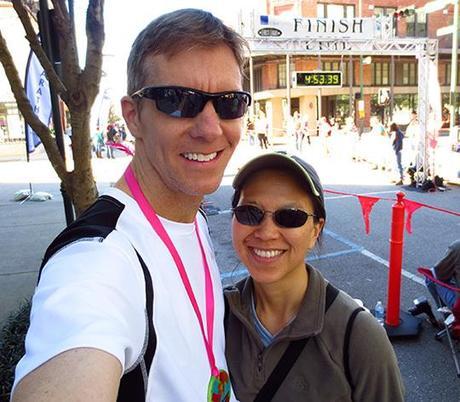
Reunited and it feels so good
The First Light of understanding
Based on Garmin data, my total elapsed time was 7 minutes, 13 seconds longer than my total moving time, meaning that – since I hadn’t stopped to eat or drink – I’d squandered over seven minutes just babysitting my stomach. Not to mention the time spent trying to talk it down between pitstops. Perhaps more telling, my average pace (including stops) of 8:29/mile contrasted sharply with my average moving pace of 8:13/mile. So at least I was running when my innards weren’t.
And Katie, upbeat ever-supportive Katie… every time she saw me (at miles 5, 10, 15 and 20), I felt like I was in an awkward hurry to get past her and to the next aid station. As usual she seemed to teleport around the course, covering more ground than some of the city’s cracked streets. She was a one-woman spectating army in both Jackson and Mobile (and the reason all my blog images don’t have “PROOF” splashed across them), and I’m lucky she enjoys the process as much as she does – even when it takes us to the Heart of Dixie.
Tentatively, I joined the festive post-race party already in progress in sun-dappled Bienville Square. In the center of the grassy plaza, under a white tent surrounded by live oak trees and a multi-tiered cast iron fountain, friendly volunteers served BBQ sandwiches with red beans and rice. Solid food at that moment sounded as appealing as a Chris Christie foot massage, so I was content to sip at the chocolate milk generously provided in a large drink dispenser. Meanwhile my stomach, starved only for more attention, refused to relinquish its moment in the sun just yet. Fortunately, we were able to stick around the post-race festivities long enough to enjoy Mobile’s own Excelsior Band:
I assumed, throughout the race and in its immediate aftermath, that my “runner’s trots” had been my body’s exaggerated response to running two hard marathons in two days. And maybe that was true – after all, stranger things have happened. In any case, I was ready to file the incident under “Lessons learned” and “Just one of those things”… until I received this email from the race organizers three days later:
We have learned that a number of runners who participated in the Marathon had complaints of stomach problems. We have been in touch with the Mobile County Board of Health about this and we want to assist them in investigating this issue.
Please respond to the survey [from the Alabama Department of Public Health] that can be reached through the link below.
Then followed a series of questions about my symptoms, and what I had and had not eaten at the pre-race pasta buffer. So in retrospect, maybe the race organizers should have commissioned an exorcist rather than a minister for the start line blessing.
On Monday I awoke with a stable stomach and greater-than-expected elasticity in my quads and IT bands. With a steady rain falling outside, we elected to spend our remaining time in the Deep South at the Mobile Carnival Museum, a small but impressively stocked attraction that chronicles Mobile’s history as “the true birthplace of Mardi Gras” dating back to 1703. The museum’s extensive collection of robes, costumes, masks, relics, photographs and a gently rocking parade float capture much of the pomp and pageantry (and Moon Pies) of Mardi Gras, all for the bargain admission price of $5 per person. Plus, the sweet and attentive older lady working the front desk sounded like a female Jimmy Carter with her soft Southern drawl. Rain or shine, the MCM is a highly recommended way to spend a couple of hours getting to know Mobile.
In the final analysis, I’d rate our whirlwind weekend in Mississippabama (Alabamassippi?) an unqualified success, having accomplished my goal of running two sub-3:45 marathons, while gaining a glimmer of appreciation for two states whose self-inflicted legacies do them no favors. Boarding our return flight from L.A. (Lower Alabama) to L.A. (Los Angeles), I had to smile as the instrumental piano version of Imagine Dragons’ “Radioactive” softly filled the cabin, just as it had four days earlier to begin our journey.
And with that, our weekend in the Deep South had come full circle… and not a moment too soon. Two marathons in two states in two days – particularly given the singular circumstances of round two – had taken a lot out of me.
Truth be told, I was pooped.
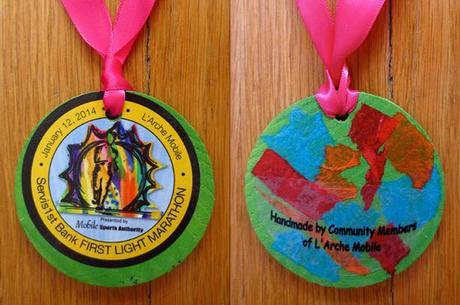
The finisher’s medallion from the front (left) and back (right)
BOTTOM LINE: Maybe this is the endorphins talking – but allowing for the fact that the organizers may have inadvertently poisoned their customers, I appreciated my 26.2-mile tour of Mobile. I always welcome the chance to support smaller races, particularly when they benefit as worthwhile a cause as L’Arche Mobile, whose members played a significant role in both the preparation and execution of the race. And as the second half of a geographically convenient back-to-back, the First Light Marathon will always hold a special place in the hearts and pocketbooks of Marathon Maniacs, Half Fanatics and 50 States runners.
PRODUCTION: First Light is a low-frills yet well-organized race. The course profile is unusual for a road marathon, in having a surprisingly hilly middle section (miles 12-21) flanked by perfectly flat stretches at the start and finish. Most important on this day was the abundance of aid stations along the course. Normally 19 aid stations would be about 18 more than I’d need, but on Sunday I found myself wishing – in the uneasy gap between stations – that there were actually more. On the bright side, I feel qualified to vouch for the cleanliness (if not the godliness) of the First Light porta-potties.
Potential dysentery notwithstanding, the pre-race pasta buffet hit the spot and was included with race registration (additional tickets were $10). And if I were running First Light next year, I’d feel confident the organizers would be extra-diligent in ensuring the Alabama Dept. of Public Health doesn’t get involved.
The First Light race shirt is a highly wearable long-sleeve black tech shirt with “MARATHON” printed along the sleeve. And as referenced above, back-to-back (Mississippi Blues Marathon/First Light Marathon) runners received their own long-sleeve white tech shirt with both race logos on the front and a “BACK 2 BACK” design on the back, as well as a commemorative plaque hand-painted by a community member of L’Arche Mobile. Nothing notable to report from the race goodie bag except the bag itself, which was both reusable and neon orange.
On-course entertainment was limited to the running commentary and frequent cries of “War Eagle!” from my blue-hued colleague. Spectators were sparse but supportive, though not as supportive as in Jackson, where everyone happily thanked us for coming. The enthusiastic orange-clad sentries stationed along the course in Jackson were replaced in Mobile by purposeful police officers whose job it was to keep both foot and motor traffic flowing smoothly.
FINAL STATS:
January 12, 2014
26.41 miles in Mobile, AL (state 7 of 50)
Finish time & pace (Official): finish time 3:44:12 (first time running the Servis1st Bank First Light Marathon), 8:34/mile average pace
Finish time & pace (Unofficial, moving): 3:36:59, 8:13/mile moving pace
Finish place: 69/533 overall, 16/52 in M(40-44) age group
Race weather: sunny and cool (starting temp 39°F)
Elevation change (Garmin Connect): 650ft ascent, 649ft descent
